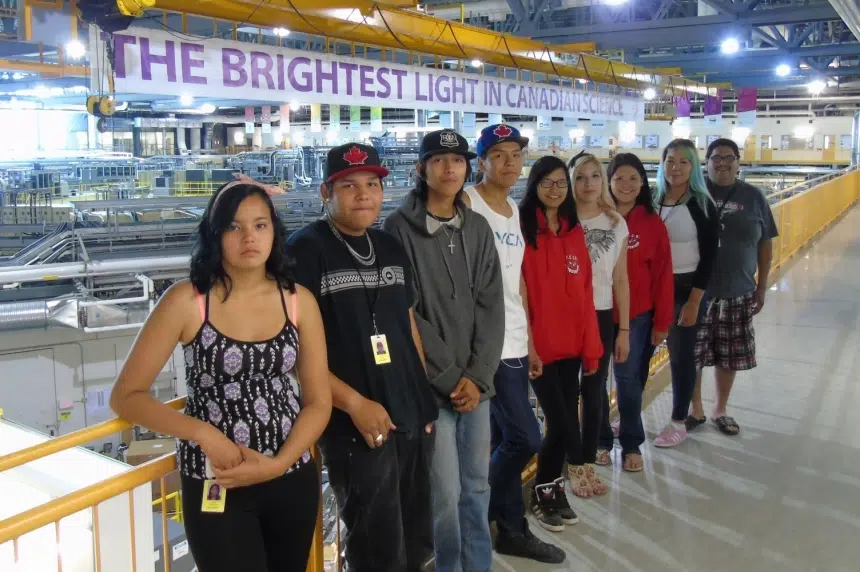A group of 10 high school students crowded a table in a conference room on the second floor of the Canadian Light Source Synchrotron. They excitedly punched in data about zinc levels in a specimen they brought from their home community, James Smith Cree Nation.
In June, the students finished up a long-running project that combines indigenous knowledge with engineering and science to find solutions to water issues on the First Nation. The project is called Nîpîy, the Cree word for water.
“The issues that we have at home is that on one of the main roads there was a big flood on one side of the reserve. So there is a big lake there now and I don’t think they can fix it because there are already fish there. Across the road… there was another lake,” Bernard Constant Community School student Taylor Brittain said.
Using the Canadian Light Source (CLS) synchrotron at the University of Saskatchewan (U of S), the students discovered what elements were inside the samples. The students were specifically looking for elements that wouldn’t naturally be in that environment, but may turn up because constant flooding has changed the landscape. Luckily, in these experiments no particularly toxic elements were found.
“The purpose of doing the project was to find out the elements in the water and how much of it there was. We found a lot of iron in most of the samples that we used, and we found quite of bit of zinc too,” student Rowddie Sanderson said. “I was actually thinking of doing (this for) my life because it’s fun doing everything, putting samples in, looking at everything and figuring everything out… it was fun using the machine.”
Student Chaz Genaille said he also enjoyed working with the samples and just being in a giant building while Dallas Burns said it was special to do it with his friends.
“My favourite part about this experience was probably just being with everybody and doing this work and the results we got, it was pretty cool how everything is different but similar,” Burns said.
Bringing the students in to be hands-on with the project was at the core ideas of the Nîpîy project, assistant professor in the Department of Indigenous Studies at the U of S Robert Innis said. Innis was the local coordinator for the project.
“The project involved originally three communities, two in Ontario, and one in Labrador,” Innis said. “They had an advisory board of about 15 to 20 people across Canada and they were academics, people who worked in the field of water and waste water treatment in Inuit First Nations and Metis communities, and non Aboriginal communities.”
One of the advisory members was from the James Smith Cree Nation who advocated on behalf of the community to get them involved in the project. The original project started in 2012 and was funded by the Canadian Water Network, while the James Smith portion began in 2013.
“The research is unique in ways because it pairs engineers with social scientists. Usually these two kinds of researches don’t work together,” Innis said. “So this was kind of unique, and what they aim was to try to determine how and to what degree can indigenous knowledge be utilized for water and waste water management.”
Innis also said the way Nîpîy applied indigenous knowledge to water and waste water was completely unique.
“When we are talking about accessing indigenous knowledge… it’s not something you can talk to elders and say ‘how can you manage water and waste water with the knowledge you have,'” Innis said. “We have to find out is there indigenous knowledge in this instance in the community, and if there is how do you access it? Then, once you access that knowledge, how then do you apply it? There is multiple layers to this that made it a little more complicated.”
The project has seen a lot of success and the students are excited to return to their community and speak about what they’ve learned. They are particularly excited to speak about the involvement of indigenous social scientists and engineers from the U of S.
“We were able to expose the students to thinking about science, but thinking about it from having indigenous engineers. Also thinking about policy implications from indigenous social sciences,” Innis said. “So hopefully having these students think ‘these guys did it so we can do it. We can go to university, get our training and come back as scientists or policy analysts .’ So ideally, in the long term, this would be a legacy we would like to see happening with the research.”
That’s especially important for the James Smith Cree Nation who have a new water treatment plant that will need engineers, maintenance and upgrades. The project also began coming up with some practical ways to apply indigenous knowledge, but unfortunately Innis said they “have kind of run out of time”.
“The first two years were really about community building, trying to figure out how we do this… Now at the end of our second year, we would be in the ideal position to go into our third year of research, (but) unfortunately we have run out of research funds,” he said, adding the Canadian Water Network no longer supplies funding to any projects. “Right now what we are trying to do is access some more research funds to carry it on for another year so that we will be able to hopefully see it through the end.”
For Science Projects Manager at CLS Robert Blyth, there is a lot of value in continuing the project.
“If the students are enthusiastic, that opens a door to the community, then the community tells the students what’s important to them and what we should be measuring,” he said.
“Hopefully this is the start of a really good dialogue between scientists here and the community up north.”
Follow on Twitter: @KellyGerMalone







